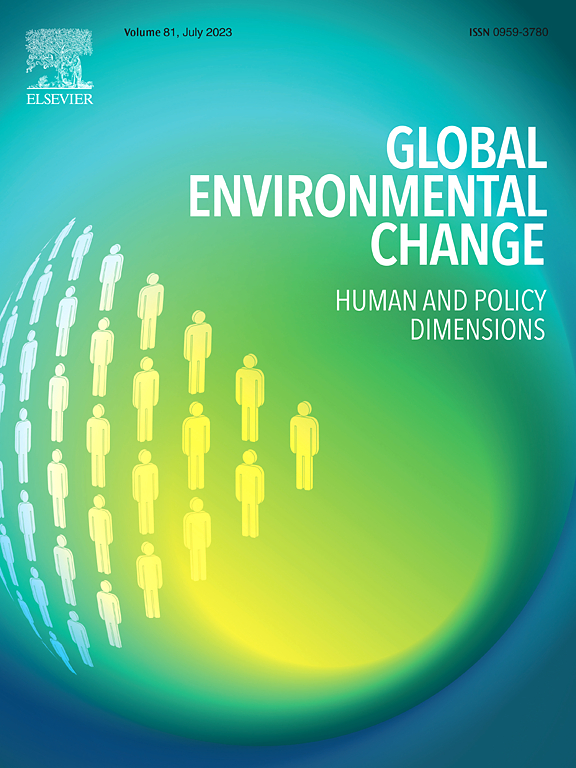曲线:在不确定情况下预测海平面上升的人种学研究
IF 9.1
1区 环境科学与生态学
Q1 ENVIRONMENTAL SCIENCES
引用次数: 0
摘要
这是研究人员首次获准观察政府间气候变化专门委员会(IPCC)的工作过程。本文通过在 IPCC 第六次评估报告第一工作组卷的编写过程中对海平面上升评估人员进行的多年系列访谈,分析了在评估复杂、不确定的科学问题时所涉及的社会和认识论挑战以及工具(包括技术和社会工具)。这项研究表明,"曲线"--未来海平面上升的代表--从三个方面体现了科学/政策互动的人文维度。首先,IPCC 作者的经验表明,重要的不仅仅是评估报告的传播结果或政治反馈,还有产生这些评估的社会和专家过程。尝试新的评估技术来提高人们对气候科学的理解,也可以提高社会对气候科学、影响和解决方案的理解。其次,全球环境评估中人的因素影响着这些组织的公信力。专家作者接受这些志愿工作的原因是多方面的,但他们对评估的社会经验的感知会影响他们的认同,并最终影响组织的合法性。第三,政府间气候变化专门委员会(IPCC)正逐步将其图表设计程序正规化,并普遍支持作者对图表进行试验。然而,人们对章节团队的社会动态如何影响图表设计和其他评估要素却知之甚少:我们通过对曲线图和文本框创作的人种学分析来证明这一点。IPCC 是一个活生生的组织:评估工作不是公式化的。要理解报告中的科学决策,我们必须了解这些决策是如何做出的。本文章由计算机程序翻译,如有差异,请以英文原文为准。
The curve: An ethnography of projecting sea level rise under uncertainty
Drawing from a multiyear series of interviews with sea level rise assessors during the development of IPCC’s Working Group I volume of the Sixth Assessment Report—the first time access had been granted to researchers to observe the IPCC process—this article analyzes the social and epistemic challenges and tools (both technical and social) involved in assessing complex, uncertain science questions. This study shows that “the curve”, a representation of future sea level rise, is an example of the human dimensions of the science/policy interaction in three ways. First, IPCC authors’ experiences demonstrate that it is not just the communicative outcomes or political feedback from assessment reports that matter, but also the social and expert processes that produce these assessments. Attempting new assessment techniques to improve understandings of climate science can also improve broader society’s understanding of climate science, impacts and solutions. Second, the human side of global environmental assessments influences the credibility of these organizations. Expert authors accept these volunteer jobs for multiple reasons but their perception of the social experience of assessment influences their buy-in, and ultimately, the legitimacy of the organization. Third, the IPCC is increasingly formalizing its procedures for figure design and generally supports author experimentation with figures. However, less is known about how the social dynamics of chapter teams influences figure design and other assessment elements: we demonstrate this through our ethnographic analysis of the creation of curve figure and text box. The IPCC is a living, breathing organization: assessment work is not formulaic. To understand the science decisions in the report, we must understand how these decisions were made.
求助全文
通过发布文献求助,成功后即可免费获取论文全文。
去求助
来源期刊

Global Environmental Change
环境科学-环境科学
CiteScore
18.20
自引率
2.20%
发文量
146
审稿时长
12 months
期刊介绍:
Global Environmental Change is a prestigious international journal that publishes articles of high quality, both theoretically and empirically rigorous. The journal aims to contribute to the understanding of global environmental change from the perspectives of human and policy dimensions. Specifically, it considers global environmental change as the result of processes occurring at the local level, but with wide-ranging impacts on various spatial, temporal, and socio-political scales.
In terms of content, the journal seeks articles with a strong social science component. This includes research that examines the societal drivers and consequences of environmental change, as well as social and policy processes that aim to address these challenges. While the journal covers a broad range of topics, including biodiversity and ecosystem services, climate, coasts, food systems, land use and land cover, oceans, urban areas, and water resources, it also welcomes contributions that investigate the drivers, consequences, and management of other areas affected by environmental change.
Overall, Global Environmental Change encourages research that deepens our understanding of the complex interactions between human activities and the environment, with the goal of informing policy and decision-making.
 求助内容:
求助内容: 应助结果提醒方式:
应助结果提醒方式:


